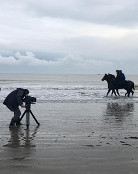Donn's Articles » Dundalk all-weather
Dundalk all-weather
You don’t need Evelyn Cusack to tell you that prospects for the staging of racing in Ireland in the immediate future look bleak. Navan Wednesday, abandoned. Fairyhouse Thursday, soft, soft to heavy in places, a covering of snow on the track. Navan Saturday, soft to heavy, a covering of snow on the track, a low of -7C forecast for tonight. (See also Navan Wednesday.) Punchestown Sunday, snow on the track, manager Richie Galway says it looks pretty bleak.
The one shining exception in all of this is Dundalk Friday: standard, no problems. Public gallops went ahead on Sunday without a hitch. It is not hugely surprising, they race on a Polytrack surface at Dundalk, an all-weather surface. We have seen on many occasions in the past – like at Wolverhampton on Friday – that an all-weather track needs some qualifying small print, but Dundalk has only ever lost one fixture to the elements, and that was when the track was enveloped by fog.
Snow is an issue. The Dundalk Polytrack was covered in three inches of snow yesterday, and if they had been scheduled to race today, a decision on whether to get the snow plough in or not would have been necessary. But at least there would have been a decision to be made, the track underneath the snow was apparently perfectly reaceable.
The type of cold weather that we get in Ireland is generally easily withstood by Dundalk’s Polytrack. Anything warmer than -12C or -14C they reckon is fine. Last year, through the bad cold spell that we had in January, Dundalk provided an essential facility for trainers to work horses. So why not race at Dundalk during the winter?
To any neutral observer, it doesn’t make sense. Here we have a top class Polytrack racing facility, the only all-weather racecourse in the country, yet it is closed during the winter months, from mid-December to early March, just at the time when turf racecourses are most at the mercy of the elements, at the exact time when an all-weather racing facility is most needed.
There is the National Hunt argument. Winter time is National Hunt time in Ireland, flat horses and flat riders take a break, it’s tradition, it’s historical. But the same was true in the UK before Lingfield and Southwell came along with their all-weather surfaces back in the early 1990s. Now, there is at least one flat fixture in the UK almost every day during the winter, 120 fixtures in all. In Ireland, between mid-December and early March, there are none. The all-weather racing facility that Dundalk provides lies idle, under-utilised. Paradoxically, the number of fixtures at Dundalk has actually been reduced from 25 this year to 23 in 2011.
Incidentally, when the prospect of building an all-weather track in Ireland was first mooted, one of the required criteria, as set out by HRI, was that the surface would be deemed suitable and safe for National Hunt racing. It was only when the realisation dawned that no such surface existed – apparently no artificial surface could be found on which falling horses and riders could slide like they do on turf – that the option to press ahead with a flat-only facility was considered.
There was talk at the time about having an all-weather surface with portable hurdles or fences sited on turf, and that may not be as outlandish as it first appears. Since Kempton built its all-weather track, there are parts of the National Hunt course that intersect the flat track. The National Hunt horses now race around the bend after the winning post on Polytrack, and some of the top riders say that it rides well, better than most turf bends. The mix of Polytrack and turf is no inconvenience to horses.
Of course, the main issue with the staging of extra fixtures during the winter at Dundalk, however, is the funding issue. From where would the prize money for the extra fixtures be generated? It is a legitimate issue, and it appears to be the main stumbling block. However, there is an appetite for it.
Dundalk want to race, the bookmakers want to race, owners want more opportunities, and most of the trainers want to race. A measure of the popularity of Dundalk lies in the fact that, at their latest meeting last Friday evening, in late November, all eight races were full, all with 14 declared runners and three reserves. Obviously it wouldn’t be top class racing through the winter, but you have to think that there would be no shortage of horses who were set to race.
At the last two meetings at Dundalk, the five leading trainers in the country were all well represented: Aidan O’Brien had nine runners, John Oxx had five, Jim Bolger had four, Dermot Weld had four and Kevin Prendergast had seven. Even deeper into the winter, it would give even the top trainers another option.
As well as that, SIS are keen to race. SIS already pay over €30,000 per meeting to Irish racecourses, but there is apparently a willingness to increase this payment to Dundalk if they were to race through the winter. There is no reason why this increase could not be used to at least part-fund the extra prize money required for the extra meetings.
We are in difficult times, we all need to begin to start to think a little laterally. We need to embrace ways in which the future can be rendered just a little less bleak.
© The Racing Post, 30th November 2010


 Follow Donn
Follow Donn